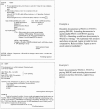Actual and potential effects of medical resident coverage on reimbursement for inpatient visits by attending physicians
- PMID: 12133156
- PMCID: PMC1495063
- DOI: 10.1046/j.1525-1497.2002.10923.x
Actual and potential effects of medical resident coverage on reimbursement for inpatient visits by attending physicians
Abstract
Context: The impact of residents on hospital finance has been studied; there are no data describing the economic effect of residents on attending physicians.
Objective: In a community teaching hospital, we compared allowable inpatient visit codes and payments (based on documentation in the daily progress notes) between a general medicine teaching unit and nonteaching general medicine units.
Design: Retrospective chart review, matched cohort study.
Setting: Six hundred fifty-bed community teaching hospital.
Patients: Patients were discharged July 1998 through February 1999 from Saint Barnabas Medical Center. We randomly selected 200 patients in quartets. Each quartet consisted of a pair of patients cared for by residents and a pair cared for only by an attending physician. In each pair, 1 of the patients was under the care of an attending physician who usually admitted to the teaching service, and 1 was under the care of a usually nonteaching attending. Within each quartet, patients were matched for diagnosis-related group, length of stay, and discharge date.
Main outcome measures: We assigned the highest daily visit code justifiable by resident and attending chart documentation, determining relative value units (RVUs) and reimbursements allowed by each patient's insurance company.
Results: Although more seriously ill, teaching-unit patients generated a mean 1.75 RVUs daily, compared with 1.84 among patients discharged from nonteaching units (P =.3). Median reimbursement, daily and per hospitalization, was similar on teaching and nonteaching units. Nonteaching attendings documented higher mean daily RVUs than teaching attendings (1.83 vs 1.76, P =.2). Median allowable reimbursements were $267 per case ($53 daily) among teaching attendings compared with $294 per case ($58 daily) among nonteaching attendings (Z = 1.54, P =.1). When only the resident note was considered, mean daily RVUs increased 39% and median allowable dollars per day 27% (Z = 4.21, P <.001).
Conclusions: Nonteaching attendings appear to document their visits more carefully from a billing perspective than do teaching attendings. Properly counter-documented, resident notes could substantially increase payments to attending physicians.
Figures

Similar articles
-
Association of resident coverage with cost, length of stay, and profitability at a community hospital.J Gen Intern Med. 2001 Jan;16(1):1-8. doi: 10.1111/j.1525-1497.2001.00314.x. J Gen Intern Med. 2001. PMID: 11251744 Free PMC article.
-
Reimbursing for residency training: how many times?Med Care. 1982 Jul;20(7):719-26. doi: 10.1097/00005650-198207000-00007. Med Care. 1982. PMID: 7121091
-
Comparison of resource utilization and clinical outcomes between teaching and nonteaching medical services.J Hosp Med. 2007 May;2(3):150-7. doi: 10.1002/jhm.174. J Hosp Med. 2007. PMID: 17549749
-
Quantifying the Opportunity Cost of Resident Involvement in Academic Orthopaedic Sports Medicine: A Matched-Pair Analysis.Arthroscopy. 2020 Mar;36(3):834-841. doi: 10.1016/j.arthro.2019.09.032. Epub 2020 Jan 7. Arthroscopy. 2020. PMID: 31919030
-
Narrative Review of Clinical Productivity and Teaching in Emergency Medicine.Cureus. 2021 Apr 5;13(4):e14309. doi: 10.7759/cureus.14309. Cureus. 2021. PMID: 33842179 Free PMC article. Review.
References
-
- Tallia AF, Swee DE, Winter RO, Lichtig LK, Knabe FM, Knauf RA. Family practice graduate medical education and hospitals' patient care costs in New Jersey. Acad Med. 1994;9:747–53. - PubMed
-
- Deamond HS, Fitzgerald LL, Day R. An analysis of the cost and revenue of an expanded medical residency. J Gen Intern Med. 1993;8:614–8. - PubMed
-
- Rosenthall E. Where It Pays Not to Teach. New York Times; February 23, 1997:4.
-
- American Medical Education. Graduate Medical Education Directory, 2000–2001. Chicago, Ill: American Medical Association; 2000.
Publication types
MeSH terms
LinkOut - more resources
Full Text Sources
